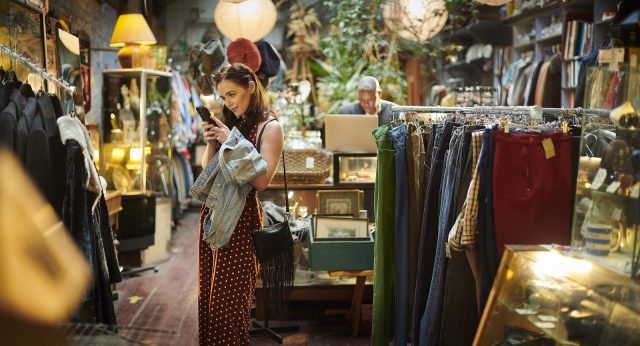Why buy vintage? Reasons abound. It’s kinder to the environment. It’s usually cheaper. It’s back in style. But did you know it may also address a deep-seated psychological need for stability amid upheavals?
Vintage consumption—that is, buying previously owned items from an earlier era—acts as a means to connect the past, present, and future. That connection across time can be reassuring, most especially in times of uncertainty. When you really want to buy a leather jacket that’s older than you are, it may be enlightening to consider the circumstances.
This vintage insight reveals itself in research by Ryan Hamilton, associate professor of marketing at Goizueta Business School. In an award-winning article titled “Stitching time: Vintage consumption connects the past, present, and future,” Hamilton—along with coauthors Gulen Sarial-Abi, Kathleen Vohs, and Aulona Ulqinaku—uncovered why we may want to turn to something old when we perceive threats to our worldviews. Notably, multiple studies have shown thoughts of death to increase the appeal of items that have already stood the test of time.
The Psychological Appeal of Thrifting
In psychology, “meaning frameworks” are how we, as human beings, interpret and understand our lives as meaningful and valuable. Threats to our meaning frameworks—i.e., the pillars propping up our worldviews—can include thoughts of death, unsettling economic upheavals, and other existential challenges.
In order to explore the effects of meaning threats on our preference for vintage, Hamilton and coauthors designed several studies. Their pilot test measured the physical health of nursing home residents. It then measured their preferences for vintage items, controlling for other variables. The results held up the researchers’ hypothesis: Vintage items—be they books, watches, bicycles, or luggage—were more strongly preferred over their modern versions by elderly participants in poorer health, presumably those most likely to have mortality on their minds.
Six subsequent studies used different variables to see if the main hypothesis continued to hold up. It did, while at the same time revealing more information about the mechanisms at work.
Death or Dental Pain
In one study, for example, researchers prompted participants with death reminders. They had to contemplate and write about their own deaths to make sure mortality was top of mind. Researchers prompted a control group with reminders of dental pain. Both groups then answered a 12-question survey about their desire for structure (e.g., set routines and practices) at that particular moment. But there was another element in this study: contemplating wearing a watch from the 1950s. As predicted by the main hypothesis, death cues were associated with participants reporting that they desired more structure. The only exceptions was for those who imagined an old watch ticking on their wrists. Vintage consumption seemed to act as a buffer against unsettling thoughts of death for them.
What is going on here? As noted above, the researchers theorize and show that vintage objects tend to connect our thoughts of the past, present, and future. These mental, intertemporal connections tend to be reassuring—“a hidden factor” in our preferences and choices, as Hamilton notes.
More than Nostalgia
One might think nostalgia—a sentimental longing for the past—could also be at work. Feeling nostalgic for one’s own past and social connections can buffer against meaning threats, as previous research has shown. But this paper was designed to tease out nostalgia. It focused on vintage’s connections across time regardless of one’s personal experiences.
“This study allowed us to clearly show that people respond differently to something they believe to be old,” as Hamilton explains. “It’s not just something that has a retro look, which was one of my favorite aspects of this project.” Hamilton and his coauthors achieved this by having participants evaluate identical items thought to be genuinely vintage or replicas. And the results were robust. Retro replicas, which can prompt nostalgia, did not have the same psychological impact as items believed to be genuinely old. For instance, 20-year-olds who find a watch from the 1950s reassuring can’t feel nostalgic about the design personally. They can, however, feel a connection across time—and that came through in the study.
Retail Therapy on the Rise?
Hamilton’s research here follows his broader interest in consumer psychology, branding, and decision-making. “When we’re buying things, we may think it’s based on strict utility maximization. However, it also might be making us feel better in some way,” says Hamilton. Shopping can serve as an emotional management strategy—for better or for worse.
Although it was outside the scope of this particular investigation (and all participants were over age 18), the insights gleaned here may help explain why 21st-century teenagers seem to be particularly avid “thrifters” these days. “I don’t want to overstate our findings. But it’s at least possible that the appeal of vintage for teenagers is boltstered by a sense of permanence and endurance that helps them during times of upheaval,” Hamilton says.
It turns out a 30-year-old leather jacket might help its new owner feel better on many levels. So is it any wonder that vintage shopping is surging in uncertain times? Fashion magazines, such as Vogue and GQ, are following the vintage craze closely in 2024. Concern for climate change and the Earth’s finite resources may present two intertwined reasons to buy old things: those two things are environmental and psychological. If tumultuous times continue amid contentious elections, wars, and other threats, it seems safe to bet on vintage.
Read More
“Stitching time: Vintage consumption connects the past, present, and future” was awarded the Journal of Consumer Psychology Best Paper Award in 2020.
In his most recently published research (2024), Hamilton looked at how consumers evaluate prices—mainly from memory, similar products nearby, and impressions left by a store. Building on previous research, Hamilton provides a framework for predicting the factors likely to influence consumers’ use of each price-evaluation strategy.
Goizueta faculty apply their expertise and knowledge to solving problems that society—and the world—face. Learn more about faculty research at Goizueta.











